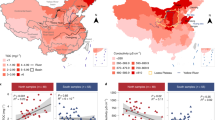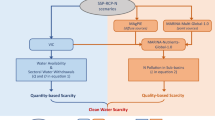Abstract
Background
Climate change influences the incidence and scope of climate extreme events that affect communities and the environment around the world. In an urban context such as Barcelona, these climate extremes can have a negative impact on drinking water quality. The worsening of drinking water quality can have important repercussions on human health, leading to the appearance of different diseases.
Objective
Investigate the association between climate extremes, in particular heavy rainfall events and drought conditions, and the drinking water quality in the city of Barcelona from 2010 to 2022.
Methods
We conducted a daily retrospective time-series study using data covering 13 years of daily monitoring of conductivity, nickel, turbidity and trihalomethanes parameters of raw water in the Llobregat River catchment area and treated water in the Drinking Water Treatment Plant (DWTP) Sant Joan Despí. We used river flow as a proxy for drought conditions and heavy rainfall events. We analyzed short-term associations between river flow rate and quality parameters in raw and treated water using generalized linear regression with distributed lag-non-linear models (DLNM).
Results
A low flow, as an indicator of drought condition or low rainfall, was significantly associated with an increase in conductivity in raw water and nickel in both raw and treated water. A high flow, as an indicator of heavy rainfall events, was significantly associated with an increase of turbidity in raw water, and a decrease in all other quality parameters.
Impact statement
This study provides novel evidence that climate extremes have an impact on the quality of drinking water in urban areas with a Mediterranean climate. The findings of this study are significant because they suggest that as the frequency and intensity of climate extremes increase due to climate change, there will be further challenges in managing and treating drinking water, which could have a detrimental effect on public health. This study serves as an important reminder of the need to strengthen and accelerate adaptation actions in water management to ensure an adequate supply of drinking water that protects the people’s health.
This is a preview of subscription content, access via your institution
Access options
Subscribe to this journal
Receive 6 print issues and online access
$259.00 per year
only $43.17 per issue
Buy this article
- Purchase on Springer Link
- Instant access to full article PDF
Prices may be subject to local taxes which are calculated during checkout


Similar content being viewed by others
Data availability
Data available upon request.
References
Villalbí JR, Ventayol I. Climate change and health in the urban context: the experience of Barcelona. Int J Heal Serv. 2016;46:389–405.
Marí M, Oliveras L, Barón-Miras LE, Borrell C, Montalvo T, Ariza C, et al. Climate change and health in urban areas with a mediterranean climate: a conceptual framework with a social and climate justice approach. Int J Environ Res Public Health. 2022;19:12764.
Ebi KL. Climate change and health. Issues Environ Sci Technol. 2021;2021:353–69.
Salvador C, Nieto R, Vicente-Serrano SM, García-Herrera R, Gimeno L, Vicedo-Cabrera AM. Public health implications of drought in a climate change context: a critical review. Annu Rev Public Health. 2023;44:213–32.
McMichael AJ. Globalization, climate change, and human health. N Engl J Med. 2013;368:1335–43. Available from: https://doi.org/10.1056/NEJMra1109341.
Cann KF, Thomas DR, Salmon RL, Wyn-Jones AP, Kay D. Extreme water-related weather events and waterborne disease. Epidemiol Infect. 2013;141:671–86.
Dolan F, Lamontagne J, Link R, Hejazi M, Reed P, Edmonds J. Evaluating the economic impact of water scarcity in a changing world. Nat Commun. 2021;12:1–10. https://doi.org/10.1038/s41467-021-22194-0.
Seneviratne SI, Nicholls N, Easterling D, Goodess CM, Kanae S, Kossin J, et al. Changes in climate extremes and their impacts on the natural physical environment. Manag Risks Extrem Events Disasters Adv Clim Chang Adapt Spec Rep Intergov Panel Clim Chang. 2012;9781107025:109–230.
IPCC. Summary for Policymakers: Climate Change 2022_ Impacts, Adaptation and Vulnerability_Working Group II contribution to the Sixth Assessment Report of the Intergovernamental Panel on Climate Change. 2022;37. https://www.ipcc.ch/report/ar6/wg2/chapter/summary-for-policymakers/.
Mishra A, Alnahit A, Campbell B. Impact of land uses, drought, flood, wildfire, and cascading events on water quality and microbial communities: a review and analysis. J Hydrol. 2021;596:125707. https://doi.org/10.1016/j.jhydrol.2020.125707.
Delpla I, Jung AV, Baures E, Clement M, Thomas O. Impacts of climate change on surface water quality in relation to drinking water production. Environ Int. 2009;35:1225–33. https://doi.org/10.1016/j.envint.2009.07.001.
Herrero A, Vila J, Eljarrat E, Ginebreda A, Sabater S, Batalla RJ, et al. Transport of sediment borne contaminants in a Mediterranean river during a high flow event. Sci Total Environ. 2018;633:1392–402. https://doi.org/10.1016/j.scitotenv.2018.03.205.
Mosley LM. Drought impacts on the water quality of freshwater systems; review and integration. Earth Sci Rev. 2015;140:203–14. https://doi.org/10.1016/j.earscirev.2014.11.010.
Aigües de Barcelona. La planta potabilizadora de Sant Joan Despí. 2020. Available from: https://www.aiguesdebarcelona.cat/es/web/guest/blog/portada/-/blogs/la-planta-potabilizadora-de-sant-joan-despi-cas.
Iglesias A, Estrela T, Gallart F. Impacts on hydric resources. Impacts of climatic change in Spain. Ministerio de Transición Ecológica. 2005; pp. 295–344. https://www.miteco.gob.es/content/dam/miteco/es/cambio-climatico/temas/impactos-vulnerabilidad-y-adaptacion/07_Impacts%20on%20hydric%20resources_ing_tcm30-178521.pdf.
Sabzevari AA, Zarenistanak M, Tabari H, Moghimi S. Evaluation of precipitation and river discharge variations over southwestern Iran during recent decades. J Earth Syst Sci. 2015;124:335–52.
Schröter D, Cramer W, Leemans R, Prentice IC, Araújo MB, Arnell NW, et al. Ecosystem service supply and vulnerability to global change in Europe. Science. 2005. Available from: https://www.science.org/doi/10.1126/science.1115233?url_ver=Z39.88-2003&rfr_id=ori:rid:crossref.org&rfr_dat=cr_pub.
Terrado M, Acuña V, Ennaanay D, Tallis H, Sabater S. Impact of climate extremes on hydrological ecosystem services in a heavily humanized Mediterranean basin. Ecol Indic. 2014;37:199–209.
Ajuntament de Barcelona. Això no és un simulacre. Declaració d’emergència climàtica. [Internet]. Barcelona; 2020. Available from: https://www.barcelona.cat/emergenciaclimatica/sites/default/files/2020-07/declaracio_emergencia_climatica_ca.pdf.
Ajuntament de Barcelona. Ecologia Urbana. How does climate change affect us? Future projections [Internet]. barcelona.cat. 2020. Available from: https://www.barcelona.cat/barcelona-pel-clima/en/how-does-climate-change-affect-us/future-projections.
La Presidencia M DE, Con Las Cortes Memoria Democrática RY. BOE. 11 enero 2023 [Internet]. Spain; 2023. Available from: https://www.boe.es.
EPA. What are the trends in the quality of drinking water and their effects on human health? [Internet]. EPA. 2022. Available from: https://www.epa.gov/report-environment/drinking-water.
WHO. Climate-resilient water safety plans. 2017. 92 p. https://www.who.int/publications/i/item/9789241512794.
World Health Organization (WHO). Guidelines for drinking-water quality. 2011. https://www.who.int/publications/i/item/9789241549950.
World Health Organization (WHO). 2100 millones de personas carecen de agua potable en el hogar. Available from: https://www.who.int/es/news/item/12-07-2017-2-1-billion-people-lack-safe-drinking-water-at-home-more-than-twice-as-many-lack-safe-sanitation#:~:text=En todo el mundo%2C alrededor,(OMS) y del UNICEF.
La pobresa hídrica i energètica a l’àrea metropolitana de Barcelona Actuació. 5.1.1.
Ministerio de la Presidencia. Real Decreto 140/2003. Bol Of del estado [Internet]. 2003;7228–45. Available from http://www.boe.es/boe/dias/2003/02/21/pdfs/A07228-07245.pdf.
World Health Organization (WHO). Guidelines for drinking-water quality [Internet]. 2011. Available from: https://www.who.int/publications/i/item/9789241549950.
Tornevi A, Bergstedt O, Forsberg B. Precipitation effects on microbial pollution in a river: Lag structures and seasonal effect modification. PLoS One. 2014;9:e98546.
Generalitat de Catalunya. Desalinizadora del Llobregat [Internet]. Available from https://www.atl.cat/es/desalinizadora-del-llobregat_2458.
Alberto Cajal. Río Llobregat: historia, características, recorrido, afluentes, flora [Internet]. Lifeder. 2019. Available from: https://www.lifeder.com/rio-llobregat/.
Barcelona À metropolitana de. Dessalinitzadora del Prat de Llobregat [Internet]. Àrea metropolitana de Barcelona. 2012. Available from: https://www.amb.cat/web/ecologia/aigua/instalacions-i-equipaments/detall/-/equipament/dessalinitzadora-del-prat-de-llobregat/348901/11818.
Agbar. Coneix la potabilitzadora de Sant Joan Despí [Internet]. 2023. Available from: https://www.museudelesaigues.cat/es/activitats/visita-potabilizadora/.
Puczko K, Jekatierynczuk-Rudczyk E. Extreme hydro-meteorological events influence to water quality of small rivers in urban area: a case study in Northeast Poland. Sci Rep. 2020;10:1–14.
Göransson G, Larson M, Bendz D. Variation in turbidity with precipitation and flow in a regulated river system-river Göta Älv, SW Sweden. Hydrol Earth Syst Sci. 2013;17:2529–42.
Silva LS, de L, Galindo IC, do Nascimento CWA, Gomes RP, Freitas, et al. Heavy metals in waters used for human consumption and crop irrigation. Rev Ambient e Agua. 2018;9:445–58.
Delpla I, Jones TG, Monteith DT, Hughes DD, Baurès E, Jung A-V, et al. Heavy rainfall impacts on trihalomethane formation in contrasting Northwestern European Potable Waters. J Environ Qual. 2015;44:1241–51.
Lenntech. Niquel [Internet]. Water tratment solutions. 2021. Available from: https://www.lenntech.es/periodica/elementos/ni.htm.
Consorci Sanitari de Barcelona. Los trihalometanos (THM) en el agua de consumo Documento informativo. 2. Available from: https://higieneambiental.com/sites/default/files/images/pdf/THM_esp.pdf.
Safe Drinking Water Foundation. Water temperature [Internet]. 2020. Available from: https://www.safewater.org/fact-sheets-1/2018/8/15/water-temperature-fact-sheet.
Gasparrini A, Armstrong B, Kenward MG. Distributed lag non-linear models. Stat Med. 2010;29:2224–34.
Gasparrini A. Modeling exposure-lag-response associations with distributed lag non-linear models. Stat Med. 2014;33:881–99.
Masoud MS, Ismail AM, El-Hoshy MM. Kinetics and thermodynamics of the formation of trihalomethanes. Appl Water Sci. 2019;9:1–6. https://doi.org/10.1007/s13201-019-0981-1.
González S, López-Roldán R, Cortina JL. Presence and biological effects of emerging contaminants in Llobregat River basin: a review. Environ Pollut. 2012;161:83–92. https://doi.org/10.1016/j.envpol.2011.10.002.
Damania R. The economics of water scarcity and variability. Oxf Rev Econ Policy. 2020;36:24–44.
Girardi R, Pinheiro A, Garbossa LHP, Torres É. Water quality change of rivers during rainy events in a watershed with different land uses in Southern Brazil. Rbrh. 2016;21:514–24.
Eerkes-Medrano D, Leslie HA, Quinn B. Microplastics in drinking water: a review and assessment. Curr Opin Environ Sci Heal. 2019;7:69–75. https://doi.org/10.1016/j.coesh.2018.12.001.
Agència Catalana de l’aigua. Les sequeres a Catalunya. 2019;
Gómez-Gutiérrez A, Navarro Bosch S, Masdeu Claramunt J, Gracia Vela J. La qualitat sanitària de l’aigua de consum humà a Barcelona [Internet]. Available from: www.primersegona.es.
Bergkamp G, Cross K. Groundwater and ecosystem services: towards their sustainable use. Int Symp Groundw Sustain. 2006;177–93. Available from: http://aguas.igme.es/igme/isgwas/PonenciasISGWAS/13-Bergkamp.pdf.
Pahl-wostl C. Transitions towards adaptive management of water facing climate and global change. Water Resour Manage. 2007;21:49–62.
Wang X, Liu L. The Impacts of Climate Change on the Hydrological Cycle and Water Resource Management. Water. 2023;15:2342.
Srivastav AL, Dhyani R, Ranjan M, Madhav S & Sillanpää M. Climate-resilient strategies for sustainable management of water resources and agriculture. Environmental Science and Pollution Research. 2021;28:41576–95.
Kronvang B, Wendland F, Kovar K, Fraters D. Land Use and Water Quality. Water. 2020;12:2412.
Cheng C, Zhang F, Shi J, Te H. What is the relationship between land use and surface water quality? A review and prospects from remote sensing perspective. Environ Sci Pollut Res. 2022;56887–907. Available from: https://doi.org/10.1007/s11356-022-21348-x.
World Health Organisation (WHO). Guidance on Water Supply and Sanitation In Extreme Weather Events. 2011;132. Available from: http://www.euro.who.int/en/health-topics/environment-and-health/water-and-sanitation/publications/2011/guidance-on-water-supply-and-sanitation-in-extreme-weather-events.
Acknowledgements
We would like to thank Aigües de Barcelona for providing the water quality and river flow data and to the DWTP Sant Joan Despí for letting us see the facilities on a guided tour.
Author information
Authors and Affiliations
Contributions
All the authors contributed to the conception and design of the study. All the authors contributed to the acquisition and interpretation of data. DB, LO and MM performed the statistical analyses. All the authors contributed to the interpretation and the discussion of the results. DB wrote the first draft of the paper. All the authors critically revised the manuscript and approved the final version. The corresponding author attests that all listed authors meet authorship criteria and that no others meeting the criteria have been omitted.
Corresponding authors
Ethics declarations
Competing interests
The authors declare no competing interests.
Additional information
Publisher’s note Springer Nature remains neutral with regard to jurisdictional claims in published maps and institutional affiliations.
Supplementary Information
Rights and permissions
Springer Nature or its licensor (e.g. a society or other partner) holds exclusive rights to this article under a publishing agreement with the author(s) or other rightsholder(s); author self-archiving of the accepted manuscript version of this article is solely governed by the terms of such publishing agreement and applicable law.
About this article
Cite this article
Benítez-Cano, D., González-Marín, P., Gómez-Gutiérrez, A. et al. Association of drought conditions and heavy rainfalls with the quality of drinking water in Barcelona (2010–2022). J Expo Sci Environ Epidemiol 34, 175–183 (2024). https://doi.org/10.1038/s41370-023-00611-4
Received:
Revised:
Accepted:
Published:
Issue Date:
DOI: https://doi.org/10.1038/s41370-023-00611-4
Keywords
This article is cited by
-
Assessing exposure and health consequences of chemicals in drinking water in the 21st Century
Journal of Exposure Science & Environmental Epidemiology (2024)



